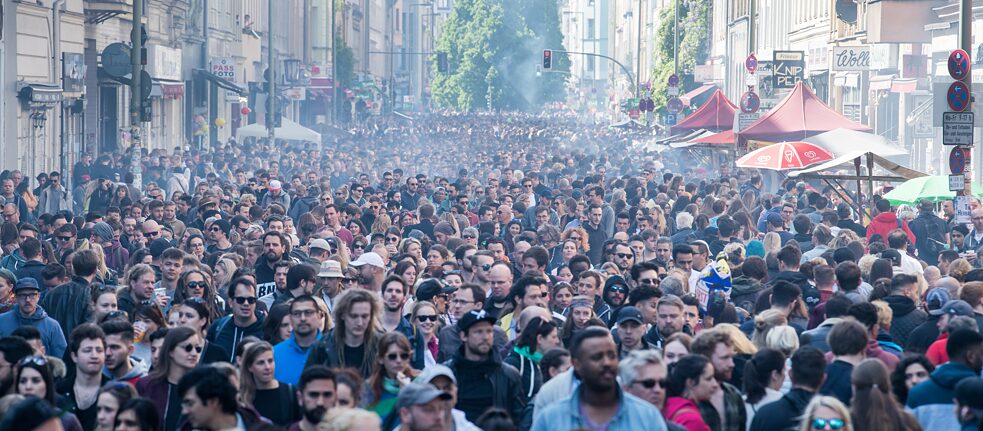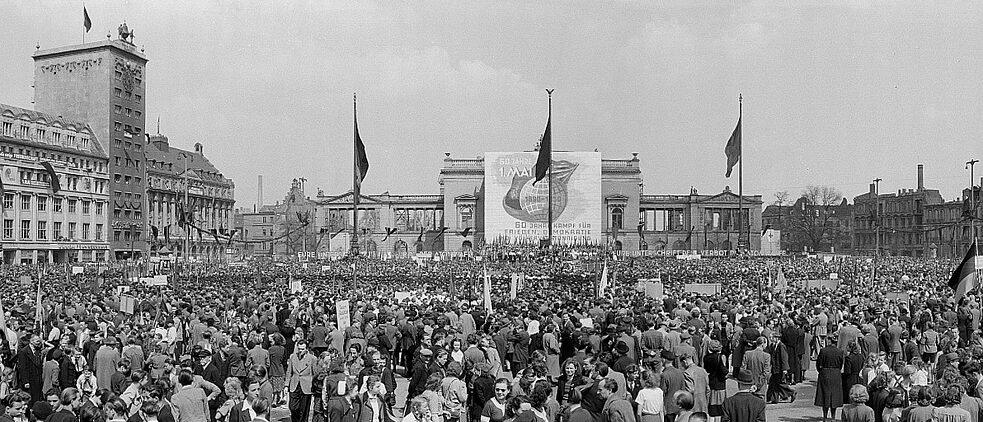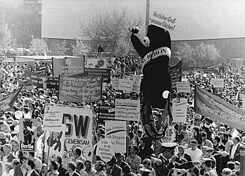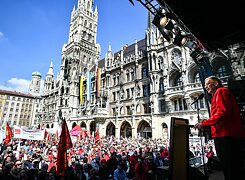International Workers’ Day
Every generation rediscovers it for itself

The first of May is celebrated as a holiday all over the world. In Germany, though, it has a unique history ranging from its appropriation by the Nazis to Berlin’s “revolutionary demonstrations”.
By Christian Werthschulte
For most countries, the history of 1st May begins in 1886 in Chicago where anarchists called for strikes and rallies to demand the eight-hour day. The peaceful demonstrations veered out of control when an unknown person threw a bomb in Haymarket Square. The police opened fire in response, dozens died, and the organisers were ultimately executed. Three years later at its 1889 founding congress in Paris, the Second International, an international federation of workers’ parties and organisations, voted to declare 1st May an International Workers’ Day in honour of the victims. This was the very first in what would turn out to be an eventful 1st May history.
In Germany, tens of thousands of people also take to the streets for rallies every 1st May. The demonstrations in Berlin-Kreuzberg, frequently accompanied by riots, are probably best known. So what is it really all about?
Controversial labour movement
Unlike today, 1st May was not yet a public holiday in Germany at the end of the 19th century. “For a long time, anyone who demonstrated on that day had to reckon with losing their job or getting arrested,” explains historian Ralf Hoffrogge, who works in Bochum and Potsdam researching the history of social movements. The general strike on 1st May 1890 in Hamburg ended in summary dismissal for everyone involved. Nevertheless, that same year Germany’s Social Democratic Party (SPD) decided to declare the first of May a day of struggle for the labour movement in Germany as well. From then on, it organised demonstrations every year, ranging from a few hundred people in smaller towns to up to 100,000 participants in major cities. The only time the SPD suspended these rallies was to support the war effort during World War I. Communist groups continued to call for demonstrations, where they also demanded an end to the war.
“The conflict between the communist and social democratic labour movements continued after the end of the war,” Hoffrogge says. This was particularly evident during “Bloody May” in 1929. The Prussian Minister of the Interior, an SPD politician, had banned demonstrations on Workers’ Day, but the Communist Party of Germany (KPD) mobilised nonetheless. Berlin police attacked the first of May demonstrators, killing at least 33 civilians and injuring 198. This “Bloody May” heightened tensions between the SPD and the KPD and weakened both in the fight against their common enemy: the National Socialists.
Nazi legacy
The National Socialists needed the support of the German workforce to consolidate their power. So they made them an offer, promising to declare 1st May the “National Labour Day” in 1933. Fearing they might otherwise lose their assets, the trade unions agreed to participate. “A terrible decision with tragic consequences,” Hoffrogge says. On 2nd May 1933, the National Socialists smashed the labour unions and absorbed their assets into Nazi organisations. It marked the end of an independent labour movement in Germany, and from 1934 on, all 1st May events were an expression of the totalitarian Nazi regime.
 First of May 1950 celebration on Augustus Square in Leipzig: In the GDR, the state SED party organised parades in honour of the first of May.
| Photo (detail): © Roger and Renate Rössing / Wikipedia / CC BY-SA 3.0
First of May 1950 celebration on Augustus Square in Leipzig: In the GDR, the state SED party organised parades in honour of the first of May.
| Photo (detail): © Roger and Renate Rössing / Wikipedia / CC BY-SA 3.0
Still, the first of May has remained a public holiday ever since, even after the end of World War II and the division of Germany, though it was celebrated differently in the East and the West. “In the GDR, 1st May was not the holiday of an independent labour movement,” Hoffrogge says. Every year, the state Socialist Unity Party of Germany (SED) organised large parades and it was tacitly assumed that everyone would take part.
In the FRG, on the other hand, trade unions took on the responsibility for organising first of May rallies. According to historian and expert on the women’s movement Gisela Notz, feminist issues were added to the traditional demands for increased co-determination, shorter working hours, and higher wages: “Trade union women were demanding ‘equal pay for equal work’ as early as the 1950s.”
Kreuzberg riots
 First of May demonstration on Konrad Adenauer Allee in West Berlin in 1987.
| Photo (detail): © Bundesarchiv, Bild 183-1987-0501-019 / Zimmermann, Peter / CC-BY-SA 3.0
The rise of the Neue Linke (New Left) from the 1960s onwards also created new tensions that spilled over into 1st May rallies. In Berlin in particular, 1st May demonstrations took up issues well beyond the classic trade union spectrum, including squatter’s rights, rents, ecology, and feminism. In 1987, the boycott of the census took centre stage. The police had raided the boycott campaign offices in the run-up to first of May, and the mood was tense. Over the course of the afternoon, street fighting broke out between the left-wing activists and the police, and thirty stores were looted.
First of May demonstration on Konrad Adenauer Allee in West Berlin in 1987.
| Photo (detail): © Bundesarchiv, Bild 183-1987-0501-019 / Zimmermann, Peter / CC-BY-SA 3.0
The rise of the Neue Linke (New Left) from the 1960s onwards also created new tensions that spilled over into 1st May rallies. In Berlin in particular, 1st May demonstrations took up issues well beyond the classic trade union spectrum, including squatter’s rights, rents, ecology, and feminism. In 1987, the boycott of the census took centre stage. The police had raided the boycott campaign offices in the run-up to first of May, and the mood was tense. Over the course of the afternoon, street fighting broke out between the left-wing activists and the police, and thirty stores were looted.
The riots were viewed with ambivalence by those in the left-wing scene: Some celebrated them as an authentic revolt, others criticized them as apolitical. Yet, they laid the groundwork for a new tradition: the revolutionary 1st May demonstrations in Berlin, frequently accompanied by riots. “With over 10,000 participants, this was the largest left-wing demonstration in Germany for a long time,” historian Hoffrogge says. It took place every year in Berlin-Kreuzberg side by side with a large multicultural street festival – until 2020.
 DGB (German Trade Union Confederation) rally in Munich on 1st May 2019.
| Photo (detail): © DGB Bayern/Philipp Guelland
The pandemic forced “Workers’ Day” into the digital realm for the past two years. Nevertheless, Hoffrogge argues: “The unions have become more confrontational in recent years.” Additionally, demands from newer groups like the tenants’ movement have taken up more space. Feminist issues have also come to the forefront again. “There has been a return to the themes of the socialist women’s movement,” Gisela Notz says, even if they are more prominent on International Women’s Day, 8th March. And Hoffrogge also finds, “There’s a need to add cross-generational references to the protests.” Perhaps that is the one constant in the varied history of the first of May in Germany: Every generation rediscovers it for itself.
DGB (German Trade Union Confederation) rally in Munich on 1st May 2019.
| Photo (detail): © DGB Bayern/Philipp Guelland
The pandemic forced “Workers’ Day” into the digital realm for the past two years. Nevertheless, Hoffrogge argues: “The unions have become more confrontational in recent years.” Additionally, demands from newer groups like the tenants’ movement have taken up more space. Feminist issues have also come to the forefront again. “There has been a return to the themes of the socialist women’s movement,” Gisela Notz says, even if they are more prominent on International Women’s Day, 8th March. And Hoffrogge also finds, “There’s a need to add cross-generational references to the protests.” Perhaps that is the one constant in the varied history of the first of May in Germany: Every generation rediscovers it for itself.